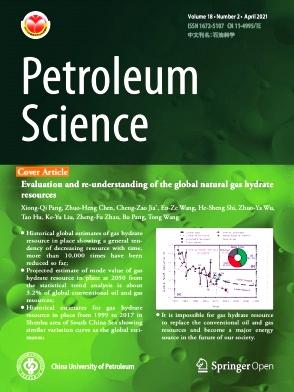复合载荷作用下碳-玻璃混合纤维抽油杆及其接头双尺度失效评价方法
IF 6.1
1区 工程技术
Q2 ENERGY & FUELS
引用次数: 0
摘要
由碳纤维增强聚合物(CFRP)芯层、玻璃纤维增强聚合物(GFRP)缠绕层和GFRP涂覆层(CFRP:GFRP = 2:3)组成的复合型连续抽油杆因其比重低、耐腐蚀性强、强度优异而被开发出来并广泛应用于油田采油。然而,HFRP杆节点及其相邻部分容易出现多模态破坏,包括断裂、脱粘和开裂。由于节理结构的复杂性和受拉、弯、扭的耦合作用,其破坏机制尚不清楚。为了解决这一问题,提出了一种双尺度的HFRP棒失效评估方法,利用宏观和细观有限元模型(FEM)。通过拉伸和弯曲实验验证了该方法,得到了φ22 mm HFRP棒的临界载荷:拉伸载荷为340.2 kN,扭矩为132.3 N m,弯矩为1192.4 N m。此外,建立了接头的综合有限元分析,确定了旋转接头颈部、树脂粘合剂和HFRP棒截面的潜在失效点。这些失效模式与实验观察结果非常吻合。此外,模拟结果表明,接缝处的应力集中使HFRP杆的拉伸强度、弯曲强度和扭转强度分别降低到原始值的61%、12%和82%。随后探讨了弯矩和扭矩对HFRP杆抗拉强度的影响,从而建立了HFRP杆节点等效疲劳评估方法。该方法基于HFRP杆和节理构件的疲劳特性,揭示了节理失效的主要原因是节理和HFRP杆对抽油杆柱动态屈曲引起的弯矩和扭矩的敏感性。利用该方法确定φ22 mm HFRP接头的疲劳极限轴向力为91.5 kN,在62.4 kN轴向力作用下,相应的疲劳极限扭矩为89.3 N m,弯矩为71.5 N m。最后,提出了采用集中加重策略提高混棒使用寿命的设计方法,并通过现场试验验证了该方法的有效性。本文章由计算机程序翻译,如有差异,请以英文原文为准。
A dual-scale failure evaluation method for Carbon-glass hybrid Fiber sucker rod and their joints under complex loads
A hybrid fiber-reinforced polymer (HFRP) continuous sucker rod, comprising a carbon fiber-reinforced polymer (CFRP) core layer, a glass fiber-reinforced polymer (GFRP) winding layer, and a GFRP coating layer (CFRP:GFRP = 2:3), has been developed and widely used in oilfield extraction due to its lower specific gravity, enhanced corrosion resistance, and superior strength. However, HFRP rod joints and their adjacent sections are prone to multi-mode failures, including fracture, debonding, and cracking. Due to the complexity of joint structure and the coupling of tension, bending, and torsion, the failure mechanism is unclear. To address this issue, a dual-scale failure assessment methodology for HFRP rods was proposed, utilizing both macro and meso finite element models (FEM). This methodology was validated through tensile and bending experiments, which yielded critical loads for the φ22 mm HFRP rod: a tensile load of 340.2 kN, a torque of 132.3 N m, and a bending moment of 1192.4 N m. Additionally, a comprehensive FEM of the joint was established, which identified potential failure points at the necking of the rotary joint, resin adhesive and the HFRP rod cross-section at the first groove tip. These failure modes closely matched the experimental observations. Furthermore, the simulation results show that stress concentration at the joint reduced the tensile, bending, and torsional strengths of the HFRP rod to 61%, 12%, and 82% of their original values, respectively. The effects of bending moments and torque on the tensile strength of HFRP rods were subsequently explored, leading to the development of an equivalent fatigue assessment method for HFRP rod joints. This method, based on the fatigue characteristics of HFRP rods and joint components, reveals that the primary cause of joint failure is the susceptibility of both the joint and the HFRP rod to bending moments and torque induced by dynamic buckling of the sucker rod string (SRS). Using this method, the fatigue ultimate axial force of the φ22 mm HFRP joint was determined to be 91.5 kN, with corresponding fatigue ultimate torque and bending moment under an axial force of 62.4 kN being 89.3 N m and 71.5 N m, respectively. Finally, a design method incorporating a concentrated weighting strategy for HFRP-steel mixed rods was proposed to enhance their service life, and its effectiveness was demonstrated through on-site testing.
求助全文
通过发布文献求助,成功后即可免费获取论文全文。
去求助
来源期刊

Petroleum Science
地学-地球化学与地球物理
CiteScore
7.70
自引率
16.10%
发文量
311
审稿时长
63 days
期刊介绍:
Petroleum Science is the only English journal in China on petroleum science and technology that is intended for professionals engaged in petroleum science research and technical applications all over the world, as well as the managerial personnel of oil companies. It covers petroleum geology, petroleum geophysics, petroleum engineering, petrochemistry & chemical engineering, petroleum mechanics, and economic management. It aims to introduce the latest results in oil industry research in China, promote cooperation in petroleum science research between China and the rest of the world, and build a bridge for scientific communication between China and the world.
 求助内容:
求助内容: 应助结果提醒方式:
应助结果提醒方式:


